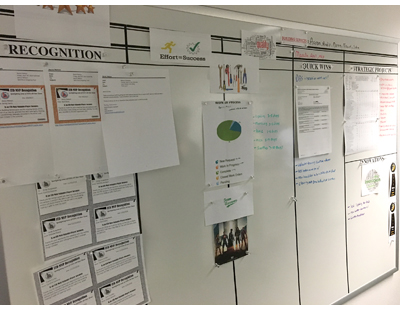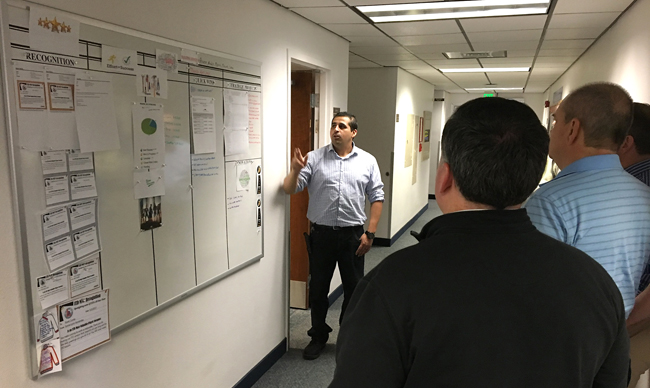

Supply supervisor Joy Morris explains her section's visual management board to a group of ITD leaders in May.
Department embraces Visual Management Boards as path
to better project management
In the transportation business, we help the driving public along roadways through visual management with signs and signals. So why wouldn't we want to use a similar process for internal communication in our own organization?
Now we are.
Last year, Chief Administrative Officer Char McArthur and managers in the Administration Division began piloting a standard "visual management board" within several sections/teams at headquarters. Teams brainstormed for several weeks to come up with a whiteboard standard they felt was representative of ITD's mission.
The boards have five sections: The first section focuses on recognizing people. The second section is about the productivity or number of resources needed to achieve the current service levels. The third section is for quality metrics. The final two sections are for quick wins the teams do each day and strategic priorities, including innovation efforts.
"Visual management lets workers communicate to management, and managers communicate to their teams what the priorities are and where the issues are," said McArthur. "This allows everyone to be focused on the same goals and be aware of the status of issues being worked on."
Stand-up meetings around the boards provide teams an opportunity to have face-to-face, two-way communication. The boards have clear goals and metrics, so teams know priorities and where they need to focus. Workers can see targets and how they are doing compared to the past so they can track progress.
The format is standard, but the content is customized by each team depending on their priorities. The teams that have been using the boards have seen improvement in internal communications and goal clarity. From ETS, to Financial Services, Supply, Purchasing and Building Services, the boards are being used with success.
Bryan Brown is manager in financial services. His team uses the board to discuss where they are on tasks to how they are progressing on special assignments. They also take time to talk about accomplishments, review lessons learned, and share innovations.
Pictured at right, left to right: Senior financial specialist Angela Simpson reports out on some her assignments, while fellow senior specialists Kirk Weiskircher and Tanya Hellewell listen and prepare for their turns.
"From the start, it has been interesting and we have just added to it. It's been kind of a trial by error," said financial specialist Angela Simpson, who attends one of the two weekly meetings Brown has with his team.
"We hear what everybody else is doing and can offer input without needing to get in a room and sit down. We get together quickly, in sometimes 15 minutes and sometimes an hour," said senior financial specialist Kirk Weiskircher with a laugh. "The thing I've enjoyed most about it is hearing what everybody else is doing, and sharing what I'm doing."
Joy Morris, a supervisor in the supply section and 18-year ITD employee, said it was difficult at first to determine how to visually demonstrate their activities, tasks and job duties using charts and graphs. While it has not been easy, she is getting used to the concept of visual management.
"It's learning to think outside the box," said Morris, who has been integral in developing the board for her team. "As you go through it, you struggle to find where it fits for you. But you feel a sense of accomplishment when you see it work."

Building Services Manager Aaron Nelson leads a recent stand-up meeting.
Published 06-16-17